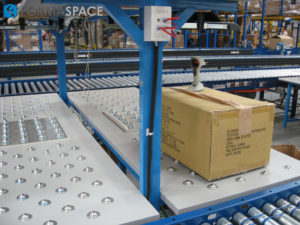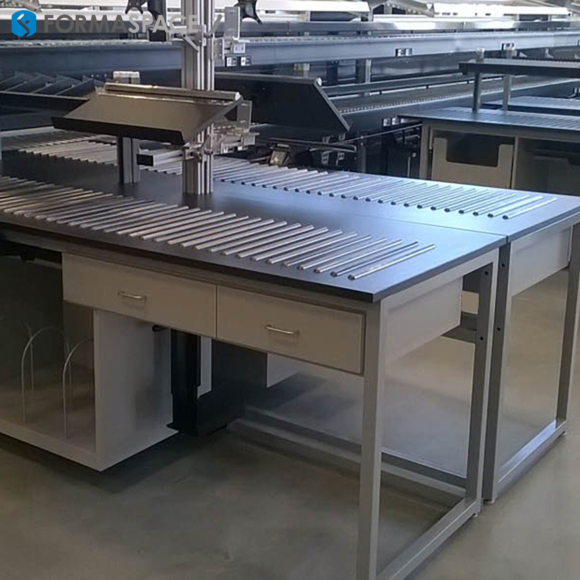Will your warehouse shipping / logistics facility add, upgrade or revamp Packing Stations in the coming year? If so, we’d like to share some of the useful “lessons learned” from designing and manufacturing Packing Stations for leading companies like Amazon, Keuhne+Nagel, and Allied Materials.

1. Assess Whether Your Facility is Lean

If you want to improve the efficiency of your packing stations, your first move is to step back and take a look at the big picture. After all, your packing station is only going to be as efficient as the operations supporting it.
As a first step, we recommend undertaking a “Rapid Plant Assessment” of your facility. This approach, which comes from the world of lean manufacturing, allows you to quickly establish a performance baseline and uncover issues by asking a series of critical questions, such as:
- Is your shipping facility hampered by things like inefficient space utilization or irregular inventory workflow?
- Is your workforce committed to productivity, safety and problem-solving?
- What is the overall commitment to quality? Are there failsafe methods in place to stop the propagation of errors?
- Would you personally buy products shipped through this facility?
Formaspace recently performed an on-site Rapid Plant Assessment for a Supply Company, the privately-owned industrial and commercial facilities supplier that specializes in next day delivery for maintenance/repair operations (MRO). Through their trademark yellow print catalog and no-nonsense online website, this company prides itself in offering over 550,000 products for industrial, mechanical, electrical, plumbing and other hard to source products. The Formaspace Rapid Plant Assessment at their location was invaluable in preparing for the design of the packing stations that would help their shipping facility in Douglasville, Georgia, streamline their operations.
2. Undertake a 5S Program to make your Packing Workflow More Efficient

Information gleaned from the Rapid Plant Assessment will help inform clients what steps are needed to improve the flow of goods to the packing workstation.
For example, if the assessment uncovered excessive buildup of unused items stored in the warehouse, your next step should be to conduct a 5S program to recover additional floor space.
If you’re not familiar with 5S program, it stems from Japanese manufacturing efficiency expert Hiroyuki Hirano and his work as an efficiency expert for Toyota. Closely related to this is the work of Robert B. Pojasek, who wrote the paper “Asking ‘Why?’ Five Times”, to uncover inefficient procedures that are hiding in plain sight.
Formaspace has helped its customers launch 5S programs at their own facilities. In many cases, a 5S program results in startling improvements; in one case we help a client recover thousands of square feet of floor space that had been used for non-essential inventory storage. In turn, freeing up this space allowed the client to cancel plans to add on to their facility – quite an impressive return on investment!
3. Customized Packing Stations Designs to Make Them Job Throughput Friendly
Once you’ve taken a look at how to improve the overall efficiency and workflow of the facility, it’s time to create detailed plans for the packing station flow.
Document all the steps from start to finish.
Identify and segregate packing workflows that are different from one another.
One size does not fit all.
For example, it’s quite common to have high-volume quantities that need to be packed in smaller shippers (e.g. shipping containers such cartons) and low volume quantities that need special attention because they are oversized, heavy or especially prone to damage in packing and/or shipping.
High-volume packing stations handling small packages can be more compact in design, allowing the worker to pack faster by taking fewer steps. On the other hand, packing stations that process large, bulky items will likely need bigger tables with built-in lifting capability to assist workers handling heavy items.
Be generous with the space allocation. Think about your busiest times of the year and plan accordingly. Too much activity in too little space will cause problems down the line. It’s also a good idea to add a little extra margin to make room for automation equipment you might acquire in the future.

4. Create Prototype Packing Station Designs to Evaluate in Real World Conditions
After you have completed the analysis, documenting all the steps required to process as quickly and efficiently as possible at the packing station, it’s time to assess a prototype design.
Formaspace can help you by building a prototype packing table station to evaluate and utilize under real-world conditions.
Take the time to develop a quality assurance plan to assess the prototype design.

- Does the Packer have sufficient table space to consolidate orders?
- Have you provided the Packer with an easily accessible method to confirm their packing list items?
- Are the “protect and pack” steps operating smoothly?
- Is it easy for the Packer to include any printed materials like special offers or documentation into the shipper?
- Can the Packer affix the label and address to the shipper without error?
- Are shipping manifests managed efficiently?
- What is the workflow for staging packed orders? How are they transported away from the packing station?
- And most importantly: what checks are in place to help prevent errors and what is the procedure to handle an error once it has been detected?
5. Incorporate Ergonomic Design Features that are Worker Friendly
As we have covered in previous articles, preventing workplace injuries is critical to the success of your operation.
You can reduce the potential for on-the-job injury at packing stations by focusing on three key areas:
First, it’s important to provide power-assisted loading tools for heavy items. This alone can reduce common injuries such as lower back pain or accidents stemming from Packers accidentally dropping heavy objects onto their feet. Formaspace can help recommend packing station solutions like powered shelves, vertical lift modules (VLM) or horizontal carousels that safely transport heavy objects through the packing process.

Second, packing stations need to accommodate different sized individuals. This means that chair and table heights need to be easily adjustable to match the stature of your Packers.
Third, when it comes to things like height adjustable work surfaces, power assist has become the new standard.
How does power assist work? Formaspace motorized furniture solutions let your Packers choose the right work surface height at the touch of a button. This means employees are more likely to adjust their work environment to achieve a proper ergonomic fit at the beginning of the shift. Power assist also makes it easy to change the height settings throughout the work shift – changing from a sitting position to a standing position for example – which can help reduce lower back pain caused by excessive hours of sitting in one position.
6. Verify Your Packing Stations are Friendly
The devil is in the details.
Choosing which packing supply items to keep on hand at a packing station – and where – can have a great impact on overall efficiency.
The goal is of course for the Packer to work quickly, without errors, and using the smallest possible shipping container adequate for the job.
This last detail is important; you want to avoid shipping large cartons filled with very few items that could drive up storage requirements and transportation costs considerably.
Having the right shipping containers in the right place can save money.
To make sure this happens, you need to verify your list of equipment, packing supplies, and materials, as well as personal items that need a home at the packing stations.
Rank these items according to how often they need to be accessed. Also take note of items that need special consideration for ergonomics – don’t locate heavy equipment on a lower shelf that requires the Packer to lift it; instead consider creating a customized, built-in tool that can swing out of the way when not in use.
Next, consider the available space surrounding the Packer. It’s a fully three-dimensional environment where items can be stored either above or below the table, to the left or to the right, or behind the Packer.
To use the space surrounding the Packer effectively, refer to your list of items created earlier that ranked each item according to how often it gets used.
Put these items used most often in the easiest to reach locations. Important tip, avoid the temptation of using table surfaces for storage.
After you located the highest ranked items, take the next group of items and find a home for each of them in the second tier storage areas. Finally, place those items that are rarely used behind the Packer.
7. Use Flexible, Modular Design Features to Allow for Future Growth

The only thing certain in the life of business is change.
One of the key design principles we believe here at Formaspace is the power of modular design.
What does this mean in practice?
Modular design means that furniture like packing stations can be updated or reconfigured as your needs change.
For example, if your shipping requirements grow, Formaspace packing tables can be extended to accommodate additional volume or to incorporate more automation technology.
Changes in consumer demand might also impact the type of product mix you are processing and shipping. Modular design means it’s possible to revise your existing furniture to make it more suitable for your current needs.
You can come back to us at any time and order matching parts to replace, extend or duplicate existing Formaspace installations. If you need to move to a new facility, modular design also makes it straightforward to disassemble, transport and reinstall Formaspace packing table installations at a new location, thus preserving your investment.
Want to Learn More About the Ins and Outs of Packing Table Design?
Our Formaspace Design Consultants stand ready to give you advice and share our experience working with major companies like Amazon, Keuhne+Nagel, Allied Materials and more.
Why not contact us today?









